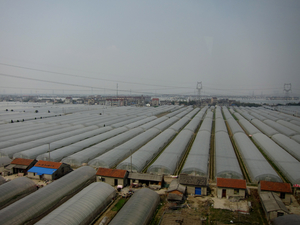Hundreds of greenhouses stretch as far as you can see in Shunyi district, on the outskirts of Beijing. It is winter time and snow is falling heavily but inside the greenhouses you can see rows of tomatoes, eggplants and other types of summer vegetables. These new greenhouses are part of China's strategy for feeding its growing urban population.
Click here to read this full issue of Supermarketwatch Asia
The government promotes them as a strategy to address the country's agricultural problems--providing sufficient and safe produces for the population--and to supply upper-middle class consumers’ with fresh organic produce. China's boom in "organic" foods is thus playing a role in the rapid disappearance of traditional peasant farming and the rise of an industrial model of standardised mass food production.
The market for certified organic foods has been growing steadily in recent years in China, thanks to increasing urban incomes and numerous food scares. Demands are high for all types of fresh vegetables and fruits, throughout the year. But, because of self-sufficiency policies in vegetable production, municipal governments are required to ensure that a high proportion of their city’s vegetable supply is produced within the municipal jurisdiction. To increase supplies of organic fruits and vegetables to meet demand, municipal governments have turned to forms of “factory farming” and marketing, such as e-marketing, that are out of step with the organic agriculture movement in many other countries.
The government promotes them as a strategy to address the country's agricultural problems--providing sufficient and safe produces for the population--and to supply upper-middle class consumers’ with fresh organic produce. China's boom in "organic" foods is thus playing a role in the rapid disappearance of traditional peasant farming and the rise of an industrial model of standardised mass food production.
The market for certified organic foods has been growing steadily in recent years in China, thanks to increasing urban incomes and numerous food scares. Demands are high for all types of fresh vegetables and fruits, throughout the year. But, because of self-sufficiency policies in vegetable production, municipal governments are required to ensure that a high proportion of their city’s vegetable supply is produced within the municipal jurisdiction. To increase supplies of organic fruits and vegetables to meet demand, municipal governments have turned to forms of “factory farming” and marketing, such as e-marketing, that are out of step with the organic agriculture movement in many other countries.
"This demand for organic foods is leading to a new class of hi-tech urban farmers and online food merchants, with rural peasants and small vendors once again being shut out of the picture."
High tech organic farming like that in Shunyi district is booming across China, with a rapid growth in “plant factories”, greenhouse energy conservation, LED plant solar energy and soil-free cultivation. Technology companies, like e-commerce giant Alibaba, are getting increasingly involved. Alibaba is now one of the leading marketers of organic produce, working in close collaboration with the new high tech farms. Online transactions of farm products were estimated at over 100 billion RMB ($16.1 billion) in 2014, accounting for 3% of the total agricultural trades in China.[1] As the selling of agricultural products via online retailing channels increases, Chinese internet giants have moved one link up in the chain to sell agricultural production tools online as well, such as seeds, fertilisers and machinery.
As eloquently explained by Prof. Jingzhong Ye, it is not easy to fully display the predicaments that millions of Chinese peasants are suffering through today, as a result of large-scale development projects, modernisation, urbanisation and commodification.[2] They have paid a huge price for the continuous economic boom of the country. The original ideas behind alternative organic food distribution systems, like community supported agriculture (CSA), was for urban consumers to pool money to support farmers in return for organic farm produce. But in China what we are seeing instead is that this demand for organic foods is leading to a new class of hi-tech urban farmers and online food merchants, with rural peasants and small vendors once again being shut out of the picture.
As eloquently explained by Prof. Jingzhong Ye, it is not easy to fully display the predicaments that millions of Chinese peasants are suffering through today, as a result of large-scale development projects, modernisation, urbanisation and commodification.[2] They have paid a huge price for the continuous economic boom of the country. The original ideas behind alternative organic food distribution systems, like community supported agriculture (CSA), was for urban consumers to pool money to support farmers in return for organic farm produce. But in China what we are seeing instead is that this demand for organic foods is leading to a new class of hi-tech urban farmers and online food merchants, with rural peasants and small vendors once again being shut out of the picture.
This article is from Supermarketwatch Asia, a quarterly email bulletin for social movements about developments in food retail and distribution in Asia produced by GRAIN (Issue No. 1, January 2016) Click here to subscribe.
[1] Eva Yoo, "E-Commerce Trade Of Agricultural Goods Over $16 Billion US In 2014", Technode, 13 July 2015. http://technode.com/2015/07/13/agricultural-goods-traded-online-go-16-billion-us-2014/
[2] Ye Jingzhong, Do not forget the real peasants while embracing the new farmers. China Agriculture University, 2015.
